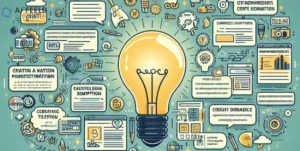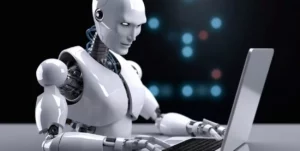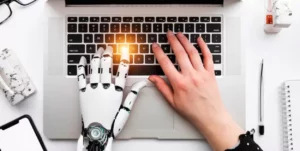In the realm of modern trading, AI trading bots have become a game changer. These bots are automated software programs that perform trading activities, ranging from conducting market analysis to executing trades, without direct human intervention. They are crafted to make split second decisions based on market data, eliminating emotional biases that often affect human traders.
Are you curious about making your own AI trading bot? Creating an AI trading bot is like teaching a computer to make smart money choices. Imagine making a robot that can study markets and do smart deals, all by itself. That’s what how to create an AI trading bot is all about. It’s exciting, and I can show you how to make it happen.
Creating an AI trading bot involves teaching a computer to make financial decisions. It’s like training a robot to buy and sell stocks automatically. Using coding and market knowledge, these bots help you trade smarter.
What are AI Trading Bots and How Do They Work?
AI trading bots are computer programs that use artificial intelligence to execute trades in financial markets automatically. These bots analyze market data, such as price movements and trading volumes, to make decisions on when to buy or sell assets like stocks or cryptocurrencies. They use intricate algorithms and machine learning to spot patterns, making swift, data based decisions without human involvement.
These bots can operate based on predefined instructions or learn from data to adapt their strategies. They work by continuously gathering and processing vast amounts of information, enabling them to react swiftly to market changes. AI trading bots aim to capitalize on market opportunities by executing trades according to specific parameters set by their developers or by learning from historical data and adjusting their strategies accordingly. These bots can be built as a personal AI assistant, offering insights, making real time decisions, and automating trading processes, thereby potentially enhancing investment efficiency and decision-making.
Benefits of AI Trading Bots
AI trading bots offer numerous benefits in the financial world. Here are some key advantages:
Efficiency: These bots operate 24/7, executing trades swiftly and efficiently without human intervention, allowing for quicker decision making in volatile markets.
Emotion Free Trading: AI bots eliminate emotional decision making, reducing the impact of fear or greed on trading, leading to more rational and consistent strategies.
Data Analysis: They can analyze vast amounts of data within seconds, identifying patterns and trends that might be missed by human traders.
Risk Management: AI bots can implement risk management strategies effectively, ensuring better control over potential losses.
Backtesting Capabilities: They can backtest strategies using historical data, refining algorithms for better future performance.
Overall, AI trading bots streamline the trading process, minimize human error, and offer a data driven approach that enhances decision making in financial markets.
The Significance of Trading Bots for Businesses
Trading bots play a crucial role in modern businesses, aiding in the automation of trading processes. These automated systems execute trades based on predefined criteria and algorithms, saving time and reducing human error. Trading bots swiftly analyze trends, react in real time, giving businesses a competitive edge, seizing profitable opportunities missed manually.
The significance of trading bots for businesses lies in their ability to operate 24/7, ensuring constant monitoring of markets globally. They facilitate quicker decision making, allowing businesses to respond promptly to market fluctuations and capitalize on favorable conditions. This automation boosts efficiency, allowing businesses to diversify investments and adapt to market changes, fostering growth and profitability.
How to Build a Trading Bot?
Building a trading bot involves creating a set of rules for buying and selling assets automatically.
Selecting a programming language
Start by choosing a programming language like Python and an API for accessing market data. When choosing a programming language for creating an AI trading bot, consider factors like its efficiency and compatibility with AI algorithms. The selected language should support data analysis, machine learning, and financial calculations to build a successful trading bot. It’s important to assess the language’s community support and available libraries for AI and finance.
Choose your trading platform and the asset you want to trade
To build an AI trading bot, start by selecting a trading platform that suits your needs. Consider the asset you wish to trade, such as stocks, cryptocurrencies, or forex. Research and choose wisely to create an effective bot that fits your trading goals.
Selecting the server to build your trading bot
When building an AI trading bot, choosing the right server is crucial. The server’s power and reliability impact the bot’s performance. A well selected server ensures the smooth operation of your trading bot. It’s essential to consider factors like speed, capacity, and compatibility when selecting the server for your AI trading bot.
Define your strategy
Building an AI trading bot involves creating a plan or strategy. First, identify the goals and objectives for the bot’s functionality. Second, decide on the data sources and indicators to inform its decision making process. Third, select the appropriate machine learning or AI algorithms for predictive analysis. Lastly, continuously test, refine, and adapt the bot’s strategy to improve its performance in the dynamic market.
Integrate with the exchange API
Integrating with the Exchange APIgy allows you to create an AI trading bot. This integration enables your bot to access market data and execute trades automatically based on AI algorithms. By connecting with APIgy, you can build a sophisticated trading system that responds to real time market changes, enhancing your investment strategy through automation.
Backtesting your trading bot
Backtesting is like a practice run for your AI trading bot. It tests how well your bot would have performed in the past. By backtesting, you analyze if your trading bot’s strategies would have made profits or losses in historical market conditions. This process helps in refining and improving the bot’s algorithms for more effective future trades.
Optimizing your trading bot
To optimize your trading bot for building an AI trading bot, focus on enhancing its algorithms. Improving data analysis and incorporating machine learning can refine its predictive abilities. Incorporate strategies that adapt to market changes, enabling your bot to make more informed decisions. Experiment with diverse indicators and variables to fine tune its performance. Regularly update and test your bot to ensure it stays competitive and effective in the dynamic trading landscape.
Forward testing
Forward testing for an AI trading bot involves testing its performance using historical data to predict how it might perform in the real market. This testing helps assess the bot’s reliability and accuracy before live trading. It allows developers to fine tune algorithms and make necessary adjustments for better real time outcomes.
Deploying and Monitoring Your Bot
When creating an AI trading bot, deploying it means putting it into action. This involves setting it up to operate in the market. Once deployed, it’s crucial to monitor the bot’s performance. Monitoring allows you to track its trades, assess its efficiency, and make necessary adjustments for better results. Regular checks and analysis are vital in ensuring the bot functions effectively in the dynamic trading environment.
What are the Limitations of AI Trading bots?

AI trading bots have limitations. They may struggle in volatile markets, unable to adapt swiftly to sudden changes. Also, they can’t anticipate unexpected world events that influence the market. These limitations often result in inaccuracies and potential financial losses for investors.
Table: Limitations of AI Trading Bots
| Limitation | Description |
| Market Volatility | Struggles to adapt quickly to sudden market fluctuations. |
| Inability to Anticipate Events | Fails to predict unforeseen global events impacting markets. |
| Risk of Inaccuracy | May lead to financial losses due to inaccuracies in decision making. |
The Future of AI in Trading
AI in trading holds significant promise for the future of financial markets. Using complex algorithms and machine learning, AI can swiftly analyze vast amounts of data, making predictions and executing trades faster and more accurately than human traders. This technology has the potential to enhance market efficiency, mitigate risks, and generate higher returns for investors.
As AI continues to evolve, it’s poised to revolutionize trading strategies, enabling more sophisticated decision making processes. With its ability to adapt to changing market conditions in real time, AI algorithms can identify patterns and trends that might be imperceptible to human analysts. This transformative technology is expected to shape the landscape of trading, offering innovative solutions and changing the dynamics of how financial markets operate.
Ethical considerations and challenges
Developing AI trading bots raises significant ethical considerations and challenges. One primary concern is ensuring that these bots operate within legal and ethical boundaries. As AI systems make rapid decisions based on vast data sets, ensuring they comply with financial regulations and ethical standards is crucial. The responsibility lies in preventing market manipulation, ensuring fairness, and avoiding any potential exploitation or unfair advantage over human traders.
Ethical challenges involve AI trading potentially replacing jobs, prompting the need for retraining and alternative employment considerations. Maintaining AI trading efficiency alongside ethical responsibility demands ongoing monitoring and oversight for fair and lawful market engagement.
FAQs
Can an AI trading bot make money?
Yes, an AI trading bot has the potential to make money by executing trades based on predefined algorithms and market analysis.
Are there any free AI trading bots?
Yes, there are free AI trading bots available in the market. Some platforms offer basic versions of AI driven trading bots for free, while more advanced features might require payment or subscription plans.
Which programming languages are commonly used to create AI trading bots?
Python is frequently used due to its simplicity and extensive libraries. Tools like TensorFlow are also popular in AI bot development.
Conclusion
In learning how to create an AI trading bot, it’s clear that the process involves complex steps, from data collection to programming algorithms. It requires a deep understanding of both financial markets and coding.
By using available resources and continuous learning, individuals can gradually master the creation of these bots. The journey to develop an AI trading bot demands patience, commitment, and a grasp of market dynamics. With persistence and dedication, crafting a successful AI trading bot becomes an achievable goal.











